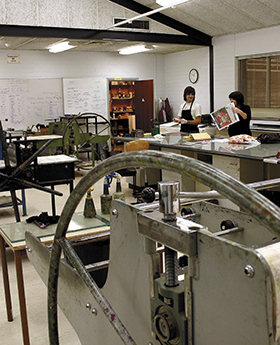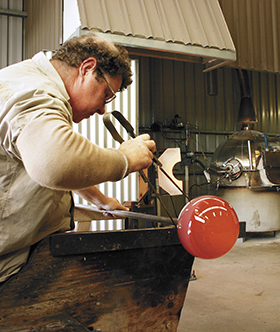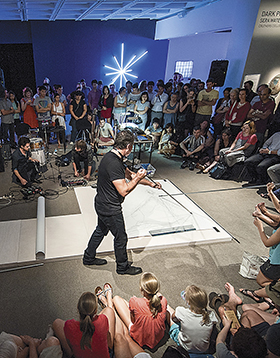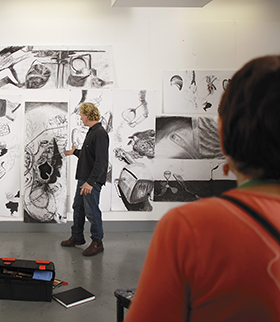 Talking Heads, Talking Art
Talking Heads, Talking Art
Words by June Moorhouse
April 2013
Four educational institutions are at the heart of the visual arts in Western Australia. Central TAFE, Curtin University, Edith Cowan University (ECU) and the University of Western Australia (UWA), in their various incarnations, have been the springboard for artists in this state for generations. Countless students have laboured in their studios, roasted around their kilns or filled windows, walls, floors and ceilings with creations. Most have walked out with a better understanding of themselves, their practice and where they might fit in the world of art. Even for those who’ve walked away, the experience of creative endeavour has enriched their lives and learning.
And beyond the student life that is the central to their function, these institutions provide employment to artists as teachers, tutors and technicians. They offer venues, resources and collaborative projects to the broader arts community; they build national and international links with artists and institutions around the world; and they generate ideas, discussion and research about the arts.
They also cop a lot of flak.
In recent weeks I’ve spoken to the leaders of each institution about the current state of enrolments in the visual arts, recent course or structural changes in each academy and their reflections on the quality of the present learning environment for the visual arts in Western Australia.
 Professor Clive Barstow
Professor Clive Barstow
Head of School, School of Communications and Arts, Edith Cowan University
Clive Barstow oversees a large School at ECU that offers programs in communications, media, design, arts and the humanities. He says that over the last 10 years visual arts enrolments have fluctuated, and in recent years have dropped slightly. Interestingly, this year there’s been a 45% increase on the previous year. As yet, it is unclear what has prompted this sudden jump in interest.
The big movement in enrolments has been in Design. “Eight years ago there were 27 students and now we have 280.” Clive thinks this reflects the advice that school leavers receive from their parents and school career advisors to pursue something that has employment prospects.
The irony in this according to Clive is that there is no significant design industry in Australia. He cites fashion as an example, which, he says, “Still operates like a cottage industry.” Unlike many European countries where there is a long-established design industry and an appreciative clientele for good design, Australia struggles to provide the scope of opportunity for graduates. Not surprisingly, he reports, many ECU design grads are going overseas to pursue their careers, and doing so with distinction.
When it comes to changes to courses, Clive says they are driven in part by demand and in part by the current key performance indicators of the university, which are inevitably linked to the policies of the government of the day. He cites the changing policy push over his time at ECU – for ‘access’, followed by ‘engagement’ and now with the focus on ‘employment’.
“Things have changed. It (visual arts) used to be a 24 unit course. Now it’s 16 studio practice units with six more generic units such as cultural theory and professional practice, etc.” Clive argues this is good pedagogy and while it does mean less studio teaching time, he thinks it prepares students more effectively for the working context that they are going into and gives them greater adaptability in their practice.
As to the specifics of course changes, Clive says that he has to have a minimum of 16 students to run an undergraduate unit of study and at ECU enrolments are strong in drawing, painting and printmaking in particular. Fashion, which now incorporates textiles, continues to operate “on the edge” but has recently experienced growth in numbers and reputation. He can’t afford to offer ceramics or glass making as a major, but both are available at unit level. Clive recognises that the crafts have suffered because they are expensive to deliver and don’t make it in the economic models that drive university survival. As best he can, he maintains the craft base and facilities so that art students have the opportunity to work in a truly cross-disciplinary way in their development of a personal praxis.
For all of the challenges of maintaining an excellent learning environment, Clive believes the graduate shows are as good as they’ve ever been. He argues that the greatest challenge remains the complacency towards art within the broader society and the seeming inability of so many people to appreciate what it takes to produce excellent work.
Digby de Bruin
Head of School, Art Portfolio, Central Institute of Technology
Central Institute is a very different beast to the universities and has a clear brief to provide students with skills related to specific practice. As Digby de Bruin points out, “We’re not training theoreticians, we’re here to provide the skills, processes and techniques, supported by conceptual development, that prepares our graduates for professional practice. We fill a niche that nobody else does.”
This makes Central a very popular destination and there’s no sign of enrolments in the visual arts waning. “Most students are attracted to either a romanticized image of life as an artist (they tend to leave very quickly) or because they have a passion and commitment to engaging in a process of making,” says Digby. Yet, he also observes that artists are less likely to end up working alone in a studio these days as many now offer their creative talents to collaborative teams made up of engineers, architects, planners and a variety of other disciplines.
This shift has inevitably led to changes in the demand for certain courses and, along with the impact of digital technology on design, has seen a drop off in crafts such as ceramics, glassmaking and textiles. Ceramics and textiles are still available at Central but most students are combining these areas with other practices. As with many other art and design schools across Australia and internationally, design courses now talk of the more generic ‘3D design’ or ‘object design’ rather than focusing on particular crafts. As with ECU, textile courses at Central are now incorporated into Fashion Design, although Jewellery/Object Design remains a popular stand-alone offering.
There is a very strong tradition of Central students moving on to university degrees and Digby sees this as a real strength of the system in Western Australia. “I think we provide the skills and mentoring for making work and university adds the reflective practice, providing a place to understand and discuss your practice,” he says. Now the institutions are exploring the possibility of greater two-way exchange in which university students may undertake some courses within Central towards an Associate Degree, allowing them to pursue particular areas of practice that are not available elsewhere.
Digby also reports that structural changes are coming which may impact on the Central programs. There is pressure to adopt the National Training packages being developed by all industry sectors. This process, coordinated by the Commonwealth Department of Education Employment and Workplace Relations, means each sector sets out the qualifications available to an industry and the competency standards that the qualifications are based on. It also specifies how people will be assessed against the competency standards.1 Digby is concerned that this approach is not well suited to art and design.
As a former Senior Curriculum Officer, Arts in the Western Australian Department of Education, Digby is particularly aware of how experiences in primary and secondary schooling flow through the tertiary sector. Central is developing stronger links with secondary schools and will soon be auspicing courses for students to undertake VET (Vocational Education and Training) courses in design and the visual arts.
This connection, together with improved attention to nurturing students as they leave the institution to set up their practice leads Digby to comment that he thinks the opportunity to develop visual artists of excellence is “better than it’s ever been.”
 Dr Jonathon Tarry
Dr Jonathon Tarry
Discipline Chair, Visual Arts, Faculty of Architecture, Landscape and Visual Arts, University of Western Australia
Jon Tarry is keen to point out that the visual arts learning environment at the University of Western Australia is completely different to the other art and design schools, given its position in the Faculty of Architecture, Landscape and Visual Arts. The trans-disciplinary approach this allows has been strengthened by sweeping changes to the structure of undergraduate degrees introduced across the university in 2012. UWA students now pursue broad-based liberal arts undergraduate degrees and specialise in their post-graduate years.
Under this new model visual arts has proven extremely popular, attracting students from many areas of study. Visual Arts is offering Video Art, Art of Expression, Art in the Environment and Art of Drawing. In 2012 the drawing unit had 130 students enrolled, one third of them medical students, one third from the communications area and the remainder from a range of other disciplines. In its second year of operation there are 18 units on offer and they will be building each year for the next two years. Jon anticipates that 1000 students per year will be going through visual arts studies.
Six staff members provide the learning opportunities in the visual arts and their advanced research interests align with the courses provided. UWA also offers an international experience and exchange opportunity in visual arts through its partnership with the Indonesian Seni Institute Denpasar (ISI) and the Bali Art Studio, managed by Ass Professor Paul Trinidad.
Jon believes that the new structure will produce more rounded students and allow them to pursue their specialty area based on the experience of their undergraduate years. In addition he says the shift has been very liberating for staff as it’s opened up many more opportunities to work in multi disciplinary settings.
UWA is geared to high achieving school leavers and focuses its students on informed research practice. “UWA is a teaching and research institution. We’re not training artists or working with the atelier model. We’ve always taken the broad-based approach with students working on projects using a range of disciplines, with practice underpinned by research,” he says.
Jon believes that the integration of research and theoretical learning with trans-disciplinary practice has produced many outstanding graduates who have gone on to make significant contributions to the arts in many different roles.
With the establishment of the Cultural Precinct at UWA in 2008, the collaboration between the various cultural facilities on campus has really opened up, which in Jon’s view adds to all that is on offer to prospective students. He cites the forthcoming opening of ARTLAAB, a student, quick response gallery on campus that has until now been operating on an informal basis; and the planned development of the old Masonic Hall in Broadway, Nedlands (former home of Black Swan State Theatre Company) as a cultural hub. These initiatives, together with the opportunities for connection and collaboration with SymbioticA, Lawrence Wilson Art Gallery and Perth Festival, make for an abundant cultural experience for students. The recent participation in LUMINOUSnight was an example of this and now Jon is working with students to create an augmented virtual sculpture project for the university, building on the Luminous experience.
For Jon, all of this makes visual arts at UWA a space to watch…
 Julian Goddard
Julian Goddard
Head of School, School of Design and Art, Curtin University
When Julian Goddard details enrolment figures at Curtin University’s School of Design and Art (SODA) it becomes quickly apparent that there is much more going on at the School than meets the eye. In addition to its on-campus activity at Bentley, SODA has students studying offshore in Mauritius and Kuala Lumpur, across the nation online and within the prison system throughout Western Australia.
Across all these modes of delivery, undergraduate visual arts enrolments are increasing between 3-4% each year and design at 10% annually. Meanwhile, Julian notes, students in the higher degree research area have increased dramatically, going from 14 to 65 in the past four years. The ability to focus on research practice for three years with the aid of a competitively gained scholarship appears to be a key driver for this increase.
Undergraduate students at Curtin now undertake a more generic year of study in the Humanities during their first year, along with units from their major, before moving on to greater speciality in the second and third years. The range of majors offered at Curtin signifies similar shifts in emphasis to their art and design school peers, with design and digital technology overtaking the more traditional crafts. Julian thinks a pendulum swing is on its way and anticipates the demand for the crafts will re-emerge. Interestingly, jewellery has remained strong at SODA with a significant number of International students drawn to the course.
“We maintain a balance of 75% studio time and 25% history and theory through text-based work, which is a pretty standard model,” Julian explains. “Our strength is in the combination of these two – the praxis – and that has been a strength of Curtin’s for a long time. We have excellent staff in the history and theoretical area which makes that possible.”
“We’re producing students who cut the mustard anywhere in the world,” Julian says, citing a string of graduates with international careers in all areas offered through art and design. He sees this as part of a long history of excellence at Curtin and believes that the “embedded knowledge” that has come through from the foundations of Perth Technical College in 1896 contribute to the school’s strength. “Everybody who’s anybody in local art and design has come through here, either as a staff member or a student. It gives us a strong sense of history and we take that very seriously.”
The greatest frustration in all of this for Julian is that Perth, “isn’t a place for world’s best practice,” which means that many students move away. “It’s a very demoralising context for students. They might get a grant and produce outstanding work for an exhibition but then hardly anyone comes and no one buys and they end up staring at it (the artwork) in their house.”
Julian believes there are policy and institutional changes that could address this brain drain and nurture a stronger art and design scene in a city with an affluent, well-educated population, but he’s not optimistic it will happen soon. Meanwhile, SODA students spread their talents around the globe, and more keep coming.
June Moorhouse has a long history of working in the arts across all sectors, in WA and nationally. She is a former journalist, Director of Fremantle Arts Centre, Australia Council Fellow and has been a consultant for 12 years.
This article featured in the Artsource Newsletter, Autumn 2013.